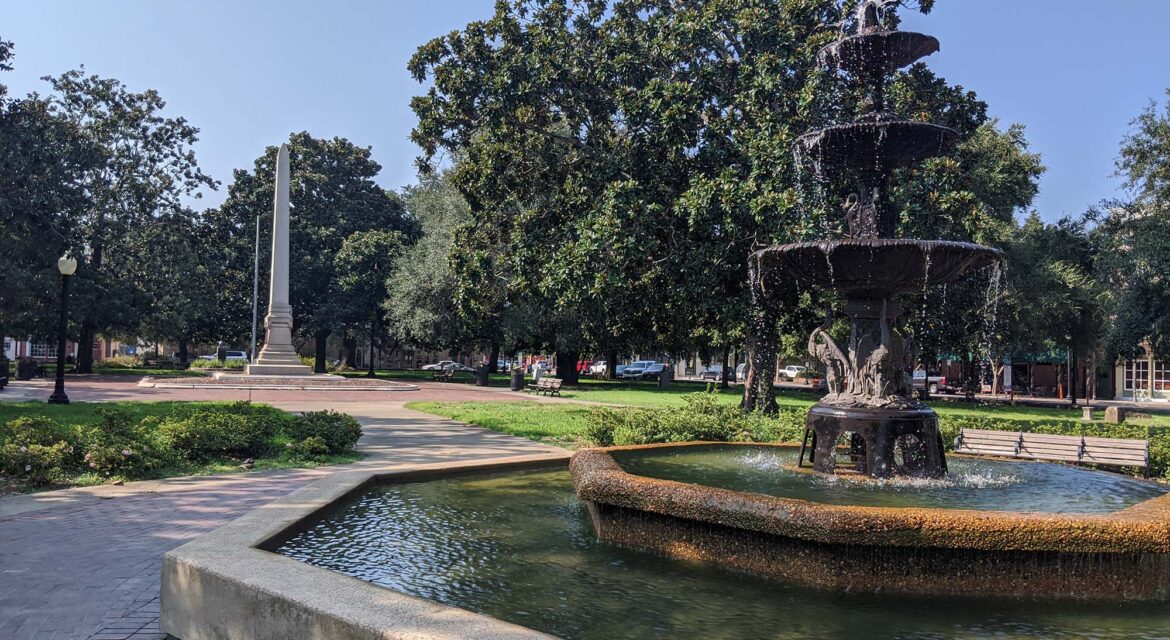 Named after King Ferdinand VII of Spain, Plaza Ferdinand VII has become a notable landmark for a variety of reasons in Pensacola, Florida. As the site of numerous important events in the history of the city and nation, Plaza Ferdinand VII would be a significant location in the city regardless of how it was laid out, but the efforts to highlight and celebrate this history while also enabling a connection to the community in the present highlight how landmarks can connect with audiences of multiple eras.
Named after King Ferdinand VII of Spain, Plaza Ferdinand VII has become a notable landmark for a variety of reasons in Pensacola, Florida. As the site of numerous important events in the history of the city and nation, Plaza Ferdinand VII would be a significant location in the city regardless of how it was laid out, but the efforts to highlight and celebrate this history while also enabling a connection to the community in the present highlight how landmarks can connect with audiences of multiple eras.
The Center of Provincial Life in Florida
 Originally the center of town life during the Colonial era, the Spanish throne gave what is now Plaza Ferdinand VII to Don Manuel Gonzalez for his services as a farmer, rancher, businessman, military advisor, and political representative of Spain. Ferdinand VII was the King of Spain between 1813 and 1833, which is why Spanish leaders gave the king’s name to the plaza.
Originally the center of town life during the Colonial era, the Spanish throne gave what is now Plaza Ferdinand VII to Don Manuel Gonzalez for his services as a farmer, rancher, businessman, military advisor, and political representative of Spain. Ferdinand VII was the King of Spain between 1813 and 1833, which is why Spanish leaders gave the king’s name to the plaza.
The plaza would become the site of the formal transfer of Florida from Spain to the United States in July of 1821. Soon after the ceremony, an official proclamation announced the transfer to the United States and the establishment of its territorial government in Florida. The location of two British forts can also be seen from the plaza. Fill dirt from the late 19th-century construction of Plaza Ferdinand VII protects the remains of the forts.
The Pensacola Historical Society erected a commemorative monument to the transfer of Florida and the swearing-in of Andrew Jackson as the Territorial Governor in the plaza in 1935. Renovated in 1985, cannons at the four corners of the plaza along with a bust of Jackson are just a few of the notable markers and monuments that define the space.

Markers, Monuments and More
 The obelisk monument in the middle of Plaza Ferdinand VII was erected to honor William D. Chipley, who was instrumental in bringing the L & N Railroad to Pensacola and points west. Additionally, a fountain that is thought to be a replica of one in Seville, Spain was placed on the site in 1909 after local citizens and school children raised funds to pay for it. A bust of Andrew Jackson resides on the spot where he was sworn in as the first Territorial Governor in 1821.
The obelisk monument in the middle of Plaza Ferdinand VII was erected to honor William D. Chipley, who was instrumental in bringing the L & N Railroad to Pensacola and points west. Additionally, a fountain that is thought to be a replica of one in Seville, Spain was placed on the site in 1909 after local citizens and school children raised funds to pay for it. A bust of Andrew Jackson resides on the spot where he was sworn in as the first Territorial Governor in 1821.
Walkways crisscross the plaza while multiple benches and places to sit are located throughout the plaza. Periodic musical and other types of events are held in the plaza, which can be booked for special or organized events. Surrounding Plaza Ferdinand is Historic Pensacola Village, which is a collection of 22 historic buildings and museums where visitors can take self-guided walking tours or guided house tours.
Featured in guides and maps of the city, Plaza Ferdinand VII is a hub of activity on account of the history it preserves as well as the experiences it creates for audiences. Doing so has enabled it to cultivate a legacy that connects the past to the future of city and region.

History and Legacy
 In becoming an officially recognized Historic Place in 1966, Plaza Ferdinand VII has been able to showcase what it looks like to celebrate the history of a space while also creating room for audiences to relax and congregate. It highlights how squares and plazas can use everything from large monuments to small markers to simple walkways to create engagement and interest.
In becoming an officially recognized Historic Place in 1966, Plaza Ferdinand VII has been able to showcase what it looks like to celebrate the history of a space while also creating room for audiences to relax and congregate. It highlights how squares and plazas can use everything from large monuments to small markers to simple walkways to create engagement and interest.


